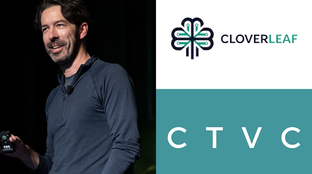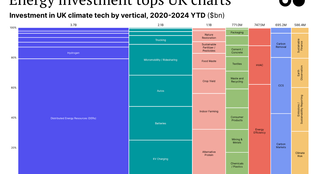
🌎 Inside Cloverleaf Infrastructure’s power play #206
Our Q&A with Brian Janous on AI, data center demand, and the need for speed
Reflecting on cleantech 1.0 and chatting with Emily from Powerhouse
Happy Monday!
For our readers impacted by the wildfires out west, we hope you are staying safe. As Gov. Newsom tweeted, “If you don’t believe in climate change, come to California.”
For this issue, we profile two female investor heavyweights and get their take on the climate tech world today.
Emily Kirsch and Powerhouse pivoted from an accelerator to a corporate climate whisperer and VC fund, and today are helping shape the conversation via their recently released innovation insights report.
Sarah Tavel (Benchmark) shares her perspective on what went wrong in Cleantech 1.0 and where mainstream investors’ perspectives are on climate tech investing today. Regarding capital intensive, difficult science start-ups, “These are areas you can’t just date; you have to marry [them].”
Rounding out the issue is a bevy of jobs, news, and an opportunity to campaign for 2020 climate candidates.
Thanks for reading!
Not a subscriber yet?
Our friends, Tommy Leep and Abe Yokell at Congruent Ventures have pulled together a great livestream interview series (cleverly titled Climate Returns) in which they discuss climate tech investing with world-class investors.
This past week’s episode #2 featured Sarah Tavel from Benchmark, who was at Bessemer during Cleantech 1.0 (CT1.0). While Sarah personally considers climate change an existential threat - “like fighting for deckchairs on the Titanic” - her professional focus remains on generalist consumer and SaaS investments.
Abe and Sarah discuss what went wrong in CT1.0 and how venture now approaches climate more than a decade later. TLDR; though mainstream VCs may start to dip their toes into the climate tech waters, they remain highly cautious of science risk from hard lessons learned during CT1.0.
What went wrong in CT1.0?
What lessons from CT1.0 can be applied to today?
What will it take for mainstream VCs to return?
⚗️ Checkerspot, a Berkeley, CA-based high-performance materials company, raised $36m in Series B funding from Viking Global Investors, Cavallo Ventures, Builders VC, and Breakout Ventures. The startup uses advanced genomics, biotechnology, and biomanufacturing to convert molecules like fatty acids and triglycerides into microalgae oils and products. More here.
📦 Sendle, a Sydney, AU-based carbon-neutral delivery service, has raised $13.7m from King River Capital, Alberts Impact Capital, and Marinya Capital. The company primarily serves as a small business courier. More here.
🐝 PowerPollen, an Ankeny, IA-based pollination improvement startup focused on enhancing agricultural productivity, has raised $13m in Series B funding from Ag Ventures Alliance, Iowa Corn Growers Association, and other investors. The startup increases yields and enables innovation through on-demand pollen preservation and application. More here.
🚚 Xos Trucks, a Los Angeles, CA-based manufacturer of electric commercial vehicles, raised $20m in funding from Proeza Ventures and BUILD Capital Group. UPS has been using Xos vehicles for the past eight months. TechCrunch has more here.
🍎 iFarm, a Helsinki, Finland-based vertical farming technology provider, has raised $4m in seed funding from Gagarin Capital, Matrix Capital, Impulse VC, and other investors. The startup’s automated system helps increase the yield of produce growing in enclosed spaces. TechCrunch has more here.
📈 Persefoni, a Tempe, AZ-based carbon footprint management platform, raised $3.5m in seed funding from Rice Investment Group, Carnrite Ventures, and other investors. The startup aims to make carbon reporting easier for large companies. TechCrunch has more here.
⚡ EnergyX, a Toronto, CA-based energy efficiency platform, raised $1m in seed funding from BDC Capital. The company enables utilities to increase customer participation in energy efficiency programs. More here.
🐮Lever VC, a New York City, NY-based seed-stage venture fund focused on funding plant-based and cell-cultivated protein startups, as well as alternative dairy companies, has raised $23m for its first fund. The firm has invested $5m in 10 early-stage companies and plans to write checks of $200k-$1m for 20 and 25 investments altogether. Food Navigator has more here.

For a lean team, Powerhouse punches well above its weight. It seems like they’re everywhere in the climate tech landscape. When we read their high quality Innovation Insights report this week, we decided that it was finally time to understand how Emily Kirsch and her team manage to have so much climate influence, particularly with corporates.
How did Powerhouse first get started?
Back in 2012 I was working at an organization founded by Van Jones. Van was friends with the music icon Prince who helped the company Mosaic get off the ground. With Prince's support, I worked with Mosaic on their pilot in Oakland and was struck by the fact that there was really no hub for clean energy entrepreneurship in the Bay Area. So in 2013 we launched Powerhouse to provide the customer and capital connections that every clean energy and mobility startup needs.
What’s changed at Powerhouse since 2012?
While we’ve always been about bringing startups, corporates, and investors together, the way that we do that now is very different from what it looked like in our early years. In 2013, we described ourselves as an incubator and accelerator. We ran a 6-month accelerator program for a few years and have since shifted our entire business model. We’ve always been a for-profit company but we now operate as an innovation firm and have also launched a venture fund.
What was the thinking behind the transition from the incubator and accelerator model to being an innovation firm and VC?
First, innovation is everywhere, and we want to see all of it. When you’re a place-based incubator and accelerator, your view may be limited to what’s right in front of you. We wanted to widen that aperture nationally and globally.
Secondly, accelerators are time-bound, and usually run on a 6-12 month cycle, yet those timing constraints are contrary to how venture actually works. With Powerhouse Ventures, which we launched in 2018, we can back the most promising seed stage, software-focused entrepreneurs wherever and whenever we find them.
You work closely with corporates. Can you share more about how you support that side of the ecosystem?
The purpose of partnering with corporates is to help them lead the next century of clean technology innovation. Some of them have been leaders for over 100 years but if they want to be around for the next 100, they need to evolve. Powerhouse works with those who embrace that reality and we help them accelerate their process.
Corporates are hyper curious to see what climate tech founders are doing on the ground. We help them tap into teams and technologies that they otherwise may not find on their own. In doing so, they may become a customer of that startup, invest in them, or even acquire them.
One of the products that we offer to our corporate and investor clients is called an Innovation Insights report which we publish quarterly.
Interesting. Tell us more about the Innovation Insights report?
The goal of the Innovation Insights reports is to 1) give corporates and investors insights into the trends that we’re seeing, often before anyone else and 2) ensure that they are aware of the startups that are most disruptive and relevant to the topics they care most about.
We’ve also quietly been building a database of thousands of startups, corporations, and investors. On the startup side, we’ve been gathering information on what tech they’re building and what it means for the industry. We have a unique perspective on how this data is indicative of trends, and by making this information available to our partners, we can help them build a decarbonized, democratized, and digitized world faster.
Our latest Innovation Insights report covers emissions management and offsets, EV charging, the landscape for fossil fuel companies in the time of COVID, and opportunities unlocked by ultacheap electricity.
What trends are you seeing in the emissions management and offsets space?
The bottom line for emissions management and offsets is that corporates will begin to fully integrate sustainability practices into operational processes and supply chains, making the simple implementation of emissions accounting and management practices increasingly important. When selecting offset projects for direct investment, additionality will be a key differentiating factor as companies consider an expanding array of solutions.
Powerhouse sees opportunities for startups across three segments of emissions management and offsets: (1) Analytics for emissions management, (2) Sourcing of “additional” projects, and (3) Tools that enable the trading of carbon credits. To access a preview of the latest Innovation Insights click here.
To learn more about how Powerhouse works with startups, corporations and investors to change the way we power our world check out Powerhouse and Powerhouse Ventures.
MIT Technology Review: Blackouts rolling through California during the heat waves blaze have been partially blamed on the grid’s ability to balance rising renewables. How can California (and the US) provide more reliable power while still increasing renewables? Energy storage, more reliable sources of carbon-free electricity, major upgrades to aging grids, and more effective demand response programs.
New York Times: European O&G majors like BP and Shell are leading the energy pivot from oil to renewables, positioning themselves less as “natural resource” extraction companies and more as “energy as a service” companies akin to electric utilities. Tech firms such as SAP, Salesforce, and startups (Persefoni) are jumping onboard by developing products for O&G producers to measure and track carbon emissions.
McKinsey: Climate stress is hurting the backbone of the global economy: infrastructure. By 2050, the average yearly cost of adapting infrastructure to climate change could average $150B to $450B through a failure of core components (e.g., the power grid, transportation, water and waste systems, and telecommunications) and several knock-on impacts.
Scientific American: In order to meet lower emissions goals, NREL (National Renewable Energy Laboratory) has unveiled a test system called ARIES which creates a virtual environment to simulate the impact of high-tech innovations such as battery and hydrogen-powered energy storage systems.
Business Insider: Lucid Motors has announced its beat the “500 mile threshold” with its debut EV Lucid Air, overcoming Tesla’s record of 402 miles. The company also claims the Air will be the fastest charging, at 20 miles per minute
Electric Jaguar I-Pace taxis will soon be able to charge wirelessly while waiting for riders in Norway through inductive charge pads supplied by Momentum. (There are two newsworthy nuggets here: (1) induction EV chargers and (2) Oslo uses Jaguars as taxis?!)
Capitalizing on wind innovation, Greentown Labs and Vineyard Wind (developer of the first utility scale offshore wind generation facility in the US) have selected SIC drone, Night Vision Technology Solutions, and Open Ocean Robotics to participate in their Offshore Wind Challenge.
Raise Green, a marketplace for (non-accredited! and accredited) investors to directly fund climate projects, has opened its second investment opportunity, with the National Energy Improvement Fund (NEIF) to finance energy efficiency and resilience improvements.
Climate activists win a “victory” electing three fossil fuel divestment proponents to Harvard’s Board of Overseers. Earlier this summer, the University already pledged that the endowment would be net zero by 2050. Are these activists the right enablers to support the work of the Harvard Management Corporation to implement this goal?
As his house burned to ashes, Diego Saez Gil, the indefatigable founder of Pachama, shares a message of resilience and steadfastness as the consequences of climate change literally become the biggest disaster of his life. He wrote, “You can’t make our mission more personal to me now.”
💡2020 is critical for climate action. Join Climate Changemakers and spend one hour per week to get climate candidates into the US Senate. No prior political action experience necessary. Simply (1) sign up, (2) pick a race and join a team and (3) take coordinated collective action (e.g., phone banking, text banking, etc,) on behalf of your candidate for one hour each week.
💡8/31 Frequency: Apply for the Fall cohort, a flexible (free!) program hosted by Pillar and Petri.bio designed to help you explore launching a startup.
🗓️8/24 Co-Invest Cleantech: Tune in for a 75 minute webinar with leaders at Black & Veatch, Aker, Mighty Cricket, Idle Smart, and Dynamhex, as part of Clean Energy Trust’s midwestern cleantech innovation series.
🗓️8/25 Insights on Solving the Climate Crisis: Join USC and UCLA for a conversation with members of the House Select Committee on the Climate Crisis about their new climate action plan. We covered the Climate Action Plan in a previous issue here.
🗓️8/26 - 8/28 emPOWER: Join Clean Energy Leadership Institute for emPOWER20 for a 3 day virtual conference, which will offer resources and community for participants passionate about clean energy technology.
Process Engineer @Plantible Foods
Software Engineer @Root AI
Hardware Engineer @Root AI
Technical Product Manager @Raptor Maps
Plant Performance Lead @Unfold
SDG Project Manager @NYU Center for Sustainable Business
Data Scientist @ThisFish
Digital Marketing Consultant, Climate Change Specialist @Empower
R&D Chemical Engineer @BioCellection
Bioengineer @New Age Meats
Food Research Technician @New Age Meats
Feel free to send us new ideas, recent fundings, or general curiosities. Have a great week ahead!

Our Q&A with Brian Janous on AI, data center demand, and the need for speed

England's new election ushers in a new test of clean energy and climate tech

H1'24 funding totaled $11.3 billion, down 20% from H1 2023.